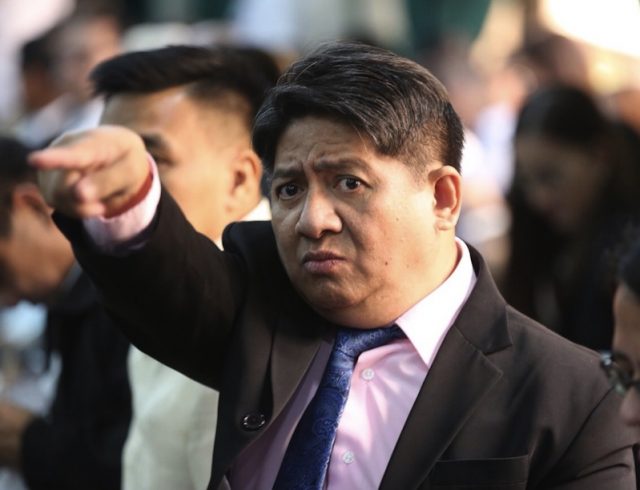MANILA – Chief Justice Maria Lourdes Sereno’s accuser in the impeachment complaint against her came under fire Wednesday after failing to provide a key document backing one allegation, and then citing a newspaper reporter as his “friend” and source to bolster his claim on the existence of such document — only to have the supposed source of the source, Associate Justice Teresita De Castro, denying she ever released any information or document.
Referring to Manila Times reporter Jomar Canlas, whom lawyer Lorenzo Gadon tagged as his source for validating information he received, Justice de Castro said in a statement to reporters,”I have never released to Jomar Canlas any information, report, or document regarding the work of the Court.”
Gadon, complainant in the impeachment case against Sereno, had claimed that Sereno “falsified” a TRO after De Castro had recommended its issuance.
During the House Committee on Justice hearing Wednesday, Gadon alleged that Sereno “committed a culpable violation of the Constitution when she falsified the temporary restraining order of the Supreme Court in G.R. No. 206844-45” (Coalition of Associations of Senior Citizens in the Philippines v. COMELEC). De Castro supposedly recommended the issuance of a TRO and sent a draft to Sereno’s office, but the final version that emerged from the CJ was vastly different.
Gadon said it was Canlas who gave him the “facts” about the incident, and that he also asked some employees of the Supreme Court about the internal matter.
Gadon acknowledged that the allegation was not based on personal knowledge, but rather, from a secondary source. But he said it was confirmed after he “investigated,” found “authentic records,” and learned that De Castro also confirmed the incident “to some other person”.
Asked by Agusan del Norte Representative Lawrence Fortun if he had authentic documents that could back his claim that falsification did occur, particularly the draft of the TRO sent to Sereno’s office, Gadon said it was not attached to his complaint, and that he did not have it in his possession.
He added, “The clerk of court failed to give it to me, saying it’s not available yet… She cannot yet find it.”
But, he said, “It can be confirmed by Justice De Castro.”
Canlas supposedly talked to De Castro, who told him that Sereno did change the TRO.
Gadon said he had another “friend” talking to De Castro in his behalf.
But the best person to shed light on the matter was De Castro herself, he said.
Oriental Mindoro 1st District Rep. Doy Leachon asked Gadon for the names of insiders who were revealing information to him, and Gadon replied that he could no longer remember the names.
Newspaper article as basis
As for the blanket TRO supposedly issued by the Chief Justice stopping the COMELEC from making further proclamations, thus benefitting other groups that were not party to the case, Fortun noted that the complaint’s reference was an article by The Manila Times titled “Justice blasts Sereno over TRO mess” from June 2013.
Fortun asked if there was a copy of the blanket TRO attached to the complaint, to which Gadon replied, “None.”
“It is agreed that at the time the allegations were made in the complaint, the supposed authentic records upon which allegation is supposed to be based was not in your possession or you haven’t read it, you haven’t seen it,” the lawmaker said.
To this Fortun replied that he has a photocopy, but knows it cannot be admitted into the records.
There was a third document in question too: the supposed falsification or tampering of the original draft.
Fortun quoted From Gadon’s complaint: “It was only after Sereno endured a harsh tongue-lashing from Justice Teresita Leonardo-De Castro, the original ponente of the tampered TRO, was the TRO rectified and re-released.”
Gadon said it was attached to the complaint.
Verified impeachment complaint
It is the first stumbling block to establishing the reliability of Gadon’s evidence, who had sworn that his is a verified impeachment complaint. This means he can raise authentic documents, or rely on personal knowledge, for each of his allegations against Sereno.
Among the allegations discussed Wednesday by the House Committee on Justice chaired by Rep. Reynaldo Umali were:
• the Resolution dated November 27, 2012 in A.M. No. 12-11-9-SC (Re: Opening the Regional Court Administrative Office in Region 7); and
• the Letter of Sereno to Associate Justice Leonardo-De Castro sometime May/June 2013, admitting that she deliberately changed the recommendation made by the latter in the TRO in Coalition of Associations of Senior Citizens in the Philippines v. COMELEC (G.R. Nos. 206844-45 and 206982, May 28, 2013).
Several lawmakers grilled Gadon for not having personal knowledge on the issues he raised against the chief magistrate.
Gadon said Associate Justice Leonardo-De Castro was willing to testify and back his claims.
However, when asked if he had personally talked with De Castro, he said he communicated through a friend.
Sereno’s lawyers quickly pounced on Gadon’s failure to show an authentic document or state that he had directly communicated with Leonardo-deCastro, tagging his allegation as “double hearsay.”
Gadon’s admission “that he based his information as relayed by a “friend” whom he identified as a certain Jomar Canlas, is clearly a violation of the hearsay rule. Hearsay is evidence of a statement that was made other than by a witness while testifying at the hearing in question and that is being offered to prove the truth of the matter stated.”
In fact, added Sereno spokesperson Atty. Josa Deinla, “when Atty. Gadon stated that Associate Justice De Castro relayed the information to Canlas and that Canlas presumably relayed it to him, that should be considered a double hearsay. Thus, Atty. Gadon is even twice removed from the alleged real source of information.”
The Sereno camp also reminded everyone that the SC had very strict confidentiality rules with respect to documents and deliberations, with tough sanctions for violators.
“Specifically, the Supreme Court sessions are executive in character, with only the Members of the Supreme Court present. The Supreme Court deliberations are confidential and shall not be disclosed to outside parties, except if authorized by the Supreme Court,” said Deinla.
The Supreme Court rollos may only be released upon an official written request from the Judicial Staff Head or the Chief of Office of the requesting Office. All persons handling the rollos are bound by the same strict confidentiality rules, Deinla added.










